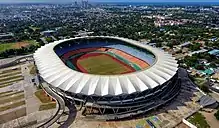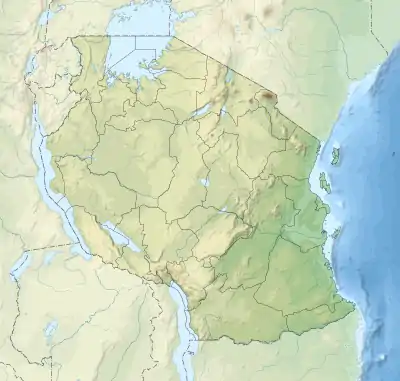National Stadium (Tanzania)
Tanzania National Main Stadium also known as Mkapa Stadium is a multi-purpose stadium in Dar es Salaam, Tanzania. It opened in 2007 and was built adjacent to Uhuru Stadium, the former national stadium. It hosts major football matches such as the Tanzanian Premier League and home matches of the Tanzania national football team.
 An aerial view of the stadium. | |
 Benjamin Mkapa Stadium Location in east Tanzania. | |
| Address | Taifa Road |
|---|---|
| Location | Dar es Salaam, east Tanzania. |
| Coordinates | 6.853563°S 39.273821°E |
| Public transit | Kurasini Station (4 km) |
| Owner | Tanzanian Government |
| Operator | Tanzania Football Federation |
| Type | Multi-purpose stadium |
| Capacity | 60,000[1] |
| Field size | 105 × 68 m |
| Surface | Grass |
| Scoreboard | Yes |
| Construction | |
| Broke ground | 2005[2] |
| Opened | 2007[2] |
| Construction cost | $56 million |
| Architect | WMS Architects (South Africa)[3] |
| Main contractors | Beijing Construction Engineering Group |
| Tenants | |
| Tanzania national football team Simba SC Young Africans FC | |
| Website | |
| www | |
With 60,000 seats it is the eleventh largest stadium in Africa and the largest stadium in Tanzania. It is owned by the Tanzanian Government. The stadium was built by Beijing Construction Engineering Group at a cost of $56 million.
A capacity crowd attended the first derby between Simba S.C. and Young Africans S.C. at the stadium in Dar es-Salaam 2008.[4] Both clubs mostly draw low attendances for their other league matches.
History
In 2000, President Benjamin Mkapa promised to build a state of the art stadium before the end of his tenure in 2005; saying that it was shameful for the country not to have a modern arena.[5] In January 2003, the government announced a tender for the construction of a new stadium to replace the dilapidated Uhuru Stadium. Sports Minister Juma Kapuya said that the government had set a budget of $60 million and eleven companies had bid for the project.[6]
In 2004, Vinci Construction, a French company won the tender with a bid of $154 million. Under pressure from the Bretton Woods Institutions, Tanzania reluctantly abandoned the project as it had received debt relief under the Highly Indebted Poor Countries Program. Deborah Brautigam in her book The Dragon's Gift: The Real Story of China in Africa writes, "To the Bretton Woods Institutions, building a modern stadium in a poor country with an annual per capita income of $330 seemed a bit like the Romans building a new Coliseum with the barbarians camped outside the city wall."[7]
In June 2004, Foreign Minister Jakaya Kikwete signed a $56 million contract with the Chinese Government,[5] who provided a grant of about $20 million.[7][8] A Chinese Embassy official described it as a "special aid project".[7] Beijing Construction Engineering Group was awarded the contract.[9] The International Monetary Fund objected that the cost had not been included in the country's annual Public Expenditure Review to its major donors.[7]
In June 2006, Chinese Premier Wen Jiabao paid a visit to the construction site.[10] The Daily News reported that Tanzania contributed TSh 25 billion of the total cost of TSh 56.4 billion.[11] In September 2007, the stadium hosted the Group 7 qualifying match between Taifa Stars and the Mozambican team for the 2008 Africa Cup of Nations.[12] The stadium also hosted the first EPL team match in the African continent when Everton played Kenya's Gor Mahia on July 13, 2017.
It served as the end point for the 2008 Summer Olympics torch relay in Dar es Salaam. Tanzania was the torch's only stop on the African continent.[13] The stadium was inaugurated by Chinese President Hu Jintao and Tanzanian President Jakaya Kikwete during the former's state visit to Tanzania in February 2009.[14]
Following the 2011 Dar es Salaam explosions at an army base, at least 4,000 people sought shelter at the stadium.[15] China formally handed over the Phase I of the complex in July 2013.[16]The stadium in Dar es-Salaam has hosted friendly matches with notable football teams across the world such as Brazil National Team, Everton and Sevilla
Stadium
It has five main entrances, a car park for 600 vehicles, 114 closed-circuit television cameras, a VIP lounge and an extendable roof.[2]
The pitch size, as lined for association football, is 105m long by 68 metres wide.
In late July 2020, the stadium was renamed after the late former president Benjamin Mkapa.[17]
Future expansion
Phase Two of the project will entail the construction of an indoor stadium, warm-up ground and a sports village/college.[16]
See also
References
- "Stadiums in Tanzania". World Stadiums. Retrieved 27 January 2015.
- Muga, Emmanuel (18 July 2007). "Tanzania's new stadium ready". BBC Sport. Retrieved 26 January 2015.
- "Dar Es Salaam National Stadium – 75000 Seats". WMS Architects. Retrieved 13 April 2015.
- http://news.bbc.co.uk/sport2/hi/football/africa/7693750.stm
- Muga, Emmanuel (6 June 2004). "Stadium backing for Tanzania". BBC Sport. Retrieved 26 January 2015.
- Muga, Emmanuel (12 March 2003). "Tanzania build for the future". BBC News. Retrieved 26 January 2015.
- Deborah Brautigam (19 November 2009). The Dragon's Gift: The Real Story of China in Africa. Oxford University Press. pp. 102–. ISBN 978-0-19-161976-2.
- Moshi, H.P.B.; Mtui, J.M. (March 2008). "Scoping Studies on China-Africa Economic Relations: The Case of Tanzania" (PDF). dspace.africaportal.org. Retrieved 26 January 2015.
- "BCEG in Tanzania". Beijing Construction Engineering Group. Archived from the original on 27 January 2015. Retrieved 26 January 2015.
- "Chinese, Tanzanian PMs inspect ultra-modern stadium site". Xinhuanet. 23 June 2006. Retrieved 26 January 2015.
- MTAMBALIKE, KILASA (24 June 2006). "Chinese Premier pleased with new stadium work". Daily News. Archived from the original on 27 September 2007. Retrieved 27 January 2015.
- Muga, Emmanuel (11 August 2007). "Dar es Salaam to host qualifier". BBC Sport. Retrieved 27 January 2015.
- "Torch in peaceful Tanzania relay". BBC News. 13 April 2008. Retrieved 27 January 2015.
- "Chinese president Hu visits stadium and cemetery for Chinese nationals". China Central Television. 16 February 2009. Retrieved 27 January 2015.
- "Tanzania blasts: At least 20 dead in Dar es Salaam". BBC News. 17 February 2011. Retrieved 27 January 2015.
- "National Stadium Handed Over". Daily News. 4 July 2013. Retrieved 27 January 2015.
- "Magufuli renames National stadium after Benjamin Mkapa". The Citizen. July 28, 2020.